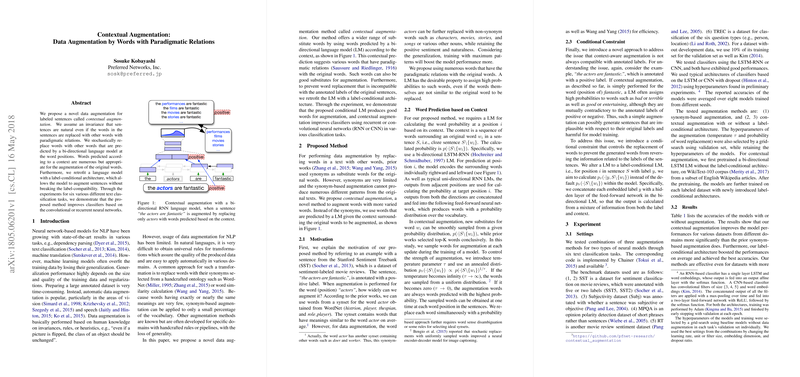Contextual Augmentation: Data Augmentation by Words with Paradigmatic Relations
The paper entitled "Contextual Augmentation: Data Augmentation by Words with Paradigmatic Relations" presents a novel methodology for augmenting labeled sentence data, termed as contextual augmentation. The authors introduce a paradigm that leverages the paradigmatic relations between words, utilizing bi-directional LLMs (LMs) to stochastically replace words in sentences without compromising their naturalness or label compatibility.
Methodology
This paper diverges from traditional synonym-based data augmentation by employing a bi-directional LSTM-RNN LLM to predict contextually appropriate word substitutions. These substitutions are drawn from a probability distribution of words, influenced by the surrounding context, thereby enabling richer diversity compared to mere synonym replacement.
The methodology incorporates a label-conditional architecture. This innovation ensures that word replacements maintain congruence with the annotated labels, preventing semantic drift that could otherwise occur when negative or contradictory substitutions are made. The approach is implemented by embedding labels into the LLM, adjusting predictions to align with label constraints.
Experimental Setup
Experiments conducted across six diverse text classification tasks, encompassing datasets such as SST (five-label and binary), Subjectivity, MPQA, RT, and TREC, exhibit the robustness of the approach. Both CNN and RNN architectures were evaluated, with the contextual augmentation method consistently outperforming synonym-based augmentation.
Results
The empirical results demonstrate that contextual augmentation, particularly when enhanced by label-conditional LMs, improves classification performance across diverse datasets:
- On average, models augmented via this method achieved enhanced accuracy rates compared to baseline and synonym-augmented counterparts.
- The contextual augmentation demonstrates its effectiveness beyond simple improvements, offering a statistically significant advantage in maintaining label integrity without task-specific considerations.
Implications and Future Directions
The findings suggest several implications for the field of NLP:
- Generalization: Contextual augmentation provides a versatile avenue for enhancing model generalization without the need for extensive labeled data.
- Label Integrity: Emphasizing label conditions adds a layer of semantic integrity, ensuring that augmented data remains valid and meaningful.
- Scalability: The proposed technique is broadly applicable across various domains, facilitating efficient integration into NLP pipelines.
Potential future directions could explore the integration of contextual augmentation with other data-driven techniques for enhanced generalization. Additionally, the application of such methodologies in unsupervised or semi-supervised contexts may present unexplored opportunities. Advancements in LLM architectures could further optimize and extend the range of effective augmentations.
In summary, this paper provides notable insights into data augmentation, presenting a structured approach through the utilization of contextual and label-conditional methodologies that enhance the utility and generalization capacity of NLP models.
